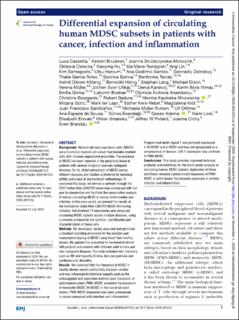| dc.contributor.author | Cassetta, Luca | |
| dc.contributor.author | Bruderek, Kirsten | |
| dc.contributor.author | Skrzeczynska-Moncznik, Joanna | |
| dc.contributor.author | Osiecka, Oktawia | |
| dc.contributor.author | Hu, Xiaoying | |
| dc.contributor.author | Rundgren, Ida Marie | |
| dc.contributor.author | Lin, Ang | |
| dc.contributor.author | Santegoets, Kim | |
| dc.contributor.author | Horzum, Utku | |
| dc.contributor.author | Godinho-Santos, Ana | |
| dc.contributor.author | Zelinskyy, Gennadiy | |
| dc.contributor.author | Garcia-Tellez, Thalia | |
| dc.contributor.author | Bjelica, Sunčica | |
| dc.contributor.author | Taciak, Bartłomiej | |
| dc.contributor.author | Kittang, Astrid Marta Olsnes | |
| dc.contributor.author | Höing, Benedikt | |
| dc.contributor.author | Lang, Stephan | |
| dc.contributor.author | Dixon, Michael | |
| dc.contributor.author | Müller, Verena | |
| dc.contributor.author | Utikal, Jochen Sven | |
| dc.contributor.author | Karakoç, Derya | |
| dc.contributor.author | Yilmaz, Kerim Bora | |
| dc.contributor.author | Górka, Emilia | |
| dc.contributor.author | Bodnar, Lubomir | |
| dc.contributor.author | Anastasiou, Olympia Evdoxia | |
| dc.contributor.author | Bourgeois, Christine | |
| dc.contributor.author | Badura, Robert | |
| dc.contributor.author | Kapinska-Mrowiecka, Monika | |
| dc.contributor.author | Gotic, Mirjana | |
| dc.contributor.author | Ter Laan, Mark | |
| dc.contributor.author | Kers-Rebel, Esther D. | |
| dc.contributor.author | Król, Magdalena | |
| dc.contributor.author | Santibañez, Juan Francisco | |
| dc.contributor.author | Müller-Trutwin, Michaela | |
| dc.contributor.author | Dittmer, Ulf | |
| dc.contributor.author | De Sousa, Ana Espada | |
| dc.contributor.author | Esendaǧli, Güneş | |
| dc.contributor.author | Adema, Gosse J. | |
| dc.contributor.author | Loré, Karin | |
| dc.contributor.author | Ersvær, Elisabeth | |
| dc.contributor.author | Umansky, Viktor | |
| dc.contributor.author | Pollard, Jeffrey W. | |
| dc.contributor.author | Cichy, Joanna | |
| dc.contributor.author | Brandau, Sven | |
| dc.date.accessioned | 2020-11-13T12:42:40Z | |
| dc.date.available | 2020-11-13T12:42:40Z | |
| dc.date.created | 2020-09-28T11:38:46Z | |
| dc.date.issued | 2020 | |
| dc.identifier.citation | Cassetta, L., Bruderek, K., Skrzeczynska-Moncznik, J., Osiecka, O., Hu, X., Rundgren, I. M., … Brandau, S. (2020). Differential expansion of circulating human MDSC subsets in patients with cancer, infection and inflammation. Journal for ImmunoTherapy of Cancer, 8(2). | en_US |
| dc.identifier.uri | https://hdl.handle.net/11250/2687818 | |
| dc.description.abstract | Background Myeloid-derived suppressor cells (MDSC) are a functional myeloid cell subset that includes myeloid cells with immune suppressive properties. The presence of MDSC has been reported in the peripheral blood of patients with several malignant and non-malignant diseases. So far, direct comparison of MDSC across different diseases and Centers is hindered by technical pitfalls and a lack of standardized methodology. To overcome this issue, we formed a network through the COST Action Mye-EUNITER (www.mye-euniter.eu) with the goal to standardize and facilitate the comparative analysis of human circulating MDSC in cancer, inflammation and infection. In this manuscript, we present the results of the multicenter study Mye-EUNITER MDSC Monitoring Initiative, that involved 13 laboratories and compared circulating MDSC subsets across multiple diseases, using a common protocol for the isolation, identification and characterization of these cells.
Methods We developed, tested, executed and optimized a standard operating procedure for the isolation and immunophenotyping of MDSC using blood from healthy donors. We applied this procedure to the blood of almost 400 patients and controls with different solid tumors and non-malignant diseases. The latter included viral infections such as HIV and hepatitis B virus, but also psoriasis and cardiovascular disorders.
Results We observed that the frequency of MDSC in healthy donors varied substantially between centers and was influenced by technical aspects such as the anticoagulant and separation method used. Expansion of polymorphonuclear (PMN)-MDSC exceeded the expansion of monocytic MDSC (M-MDSC) in five out of six solid tumors. PMN-MDSC expansion was more pronounced in cancer compared with infection and inflammation. Programmed death-ligand 1 was primarily expressed in M-MDSC and e-MDSC and was not upregulated as a consequence of disease. LOX-1 expression was confined to PMN-MDSC.
Conclusions This study provides improved technical protocols and workflows for the multi-center analysis of circulating human MDSC subsets. Application of these workflows revealed a predominant expansion of PMN-MDSC in solid tumors that exceeds expansion in chronic infection and inflammation. | en_US |
| dc.language.iso | eng | en_US |
| dc.publisher | BMJ Publishing Group | en_US |
| dc.rights | Navngivelse-Ikkekommersiell 4.0 Internasjonal | * |
| dc.rights.uri | http://creativecommons.org/licenses/by-nc/4.0/deed.no | * |
| dc.title | Differential expansion of circulating human MDSC subsets in patients with cancer, infection and inflammation | en_US |
| dc.type | Peer reviewed | en_US |
| dc.type | Journal article | en_US |
| dc.description.version | publishedVersion | en_US |
| dc.rights.holder | © Author(s) (or their employer(s)) 2020. | en_US |
| dc.subject.nsi | VDP::Medisinske Fag: 700::Klinisk medisinske fag: 750::Onkologi: 762 | en_US |
| dc.source.pagenumber | 1-13 | en_US |
| dc.source.volume | 8 | en_US |
| dc.source.journal | Journal for ImmunoTherapy of Cancer (JITC) | en_US |
| dc.source.issue | 2 | en_US |
| dc.identifier.doi | 10.1136/jitc-2020-001223 | |
| dc.identifier.cristin | 1834131 | |
| cristin.ispublished | true | |
| cristin.fulltext | original | |
| cristin.qualitycode | 1 | |

